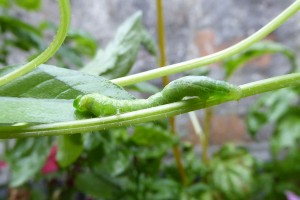Caterpillars are the larvae of butterflies and moths. They are voracious eaters can can easily destroy a crop. The two most common caterpillars we deal with in our garden are the cabbage butterfly larvae and the larvae of the tomato bud worm.
Preventive measures to avoid caterpillar problems
- Plant companion plants! This confuses the parent butterfly and deters it.
- Avoid dry stress and mulch beds in dry conditions.
- Avoid underfeeding of plants.
- Regularly, every second week and after strong rain apply worm-juice or seaweed solution (should look like a thin tea, 1/2 a watering can per bed) as a tonic for the plants.
- Build nets around the crops we know to be vulnerable: tomato, chili, the cabbage family. The mesh size of the net needs to be fine enough to physically block the parent animal, a moth or butterfly, from reaching the plant.
Dealing with caterpillars infestations:
- Collect the caterpillars you can find and manually destroy them.
- Remove infested plant material. You can put it into the compost, the caterpillar will not survive composting.
- In cases of serious infestations or under tight netting apply a spray containing bacterial spores (bacillus thuringiensis). These bacteria do not affect humans, but they will make the caterpillars ill and die.
The recipe uses a commercial product called Dipel, read more here.
